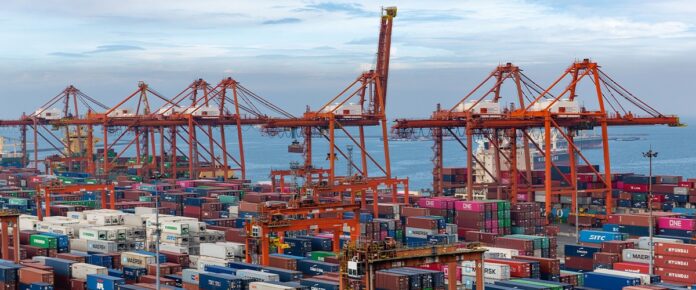
-
ICTSI bares projects supporting digital transformation
-
These include a Manila International Container Terminal mobile app, “manifesting” feature of the Terminal Appointment Booking System, driver messaging system, facial recognition to identify truck drivers, remote crane monitoring system, and Waze-like navigation app within MICT
-
Since the start of the pandemic, MICT has seen a 100-fold acceleration in its digital transformation
International Container Terminal Services, Inc. (ICTSI) will roll out several projects, including a new mobile app, as part of its digital transformation to further improve operations of its flagship, Manila International Container Terminal (MICT).
The MICT mobile app will include features such as the Track and Trace, and should allow users to access the Advance Customer Transaction System (ACTS) and Terminal Appointment Booking System (TABS).
Due to the pandemic, MICT’s digital transformation has accelerated 100-fold, ICTSI information technology systems and services director Reynaldo Mark Cruz, Jr. said in a recent presentation at the 6th Logistics Summit.
Cruz said since the start of the pandemic, MICT’s focus has been on leveraging technology to remove any need for physical presence at the terminal, eliminate face-to-face transactions, and shorten stay of stakeholders at the facility.
He cited as example the utilization of MICT’s ACTS, which hit 100% in 2020 when lockdowns were implemented due to the pandemic, from just around 30% adoption in the first three years of implementation.
ACTS allows MICT customers to settle port charges online and print the required documents to deliver or retrieve their cargo. ICTSI has already closed its billing center, which previously had the most visitor traffic in the terminal, as part of transition to 100% online payments.
In partnership with the Bureau of Customs (BOC) and Department of Agriculture-attached agencies, MICT last year also started the BOC examination online viewing, which allows customers to view examination of their shipments online, eliminating the need for their physical presence at the terminal.
READ: BOC kicks off online viewing for cargo examination
In addition, ICTSI entered into a strategic partnership with Smart Communications late last year to deploy 5G technology in the entire yard, setting up the stage “for us to be a lot more agile in employing new solutions in our pursuit to make MICT the smartest port in the country”, Cruz said.
The technology was first used in the rubber-tired gantry (RTG) cranes weighing system. All RTGs have been fitted with 5G transmitters that send the weight data of each container they hoist to the server. From the old process where truck drivers had to drive and queue at the weighbridges, now RTFs capture weight automatically, significantly cutting the time a driver spends at the terminal, Cruz explained.
What’s in the pipeline
Projects in the pipeline include deployment later this year of a “manifesting” feature in the TABS. The feature entails the client putting in container data and truck plate number while securing a TABS appointment, eliminating the need for truck driver to transact at the gate kiosk and in the process accelerating terminal ingress.
TABS is a government-approved system that requires port stakeholders to secure an online appointment before trucks can enter the container terminal to discharge and/or pick up cargo. It was piloted in October 2015 and fully implemented on March 16, 2016.
READ: All systems go for Manila ports’ online terminal booking facility
Later this year, Cruz said ICTSI will replace fingerprint readers at the gates with cameras running facial recognition as a new way of logging drivers’ identity.
Another project in the pipeline is a driver messaging system that will inform truck drivers via SMS whenever the BOC has lifted its x-ray hold on containers.
Right now Cruz said when containers are tagged by BOC for x-ray, truck drivers first park their vehicles while waiting for results. Sometimes they would congregate and wait around the x-ray office or sleep in their trucks while waiting, then randomly estimate the time when they should head to the office to check if the inspection is over.
Cruz said by capturing the driver’s mobile number during the TABS booking, the system will be able to send an SMS to the driver the moment BOC lifts the x-ray hold on the container.
Another project is the remote safety monitoring system, which will make use of MICT’s new intelligent surveillance system composed of close to 300 cameras installed around the terminal.
The system has speed detection, alerts for vehicles parked for an extended period, automatic capture of drivers who disembark and loiter around the terminal, and other artificial intelligence-aided monitoring.
Cruz said this will allow ICTSI to reduce manpower deployed on the ground for safety monitoring.
The port operator will also have a remote crane monitoring system. With the installation of sensors on MICT cranes, more visibility will be gained on the real-time condition and performance of every crane so that engineers have prior knowledge of equipment issues and bring the right tools for the job.
In addition, ICTSI plans to maximize the GPS functionality of mobile devices to provide drivers estimated time of arrival (ETA) to the facility and have the ability to modify appointments on the fly based on their ETA, thereby avoiding potential penalties, Cruz said.
ICTSI is likewise eyeing the use of geofencing, or the use of GPS or RFID technology to create a virtual geographic boundary. Cruz said ICTSI can “even remove our inbound gates eventually,” as all details of the container will be in the mobile app and the terminal can detect the location of the truck through the GPS feature of the driver’s mobile device.
Cruz said another ambitious plan is for ICTSI to aid the driver in navigating his way inside the terminal by providing a Waze-like application that can direct the driver to the right location inside the facility. – Roumina Pablo




